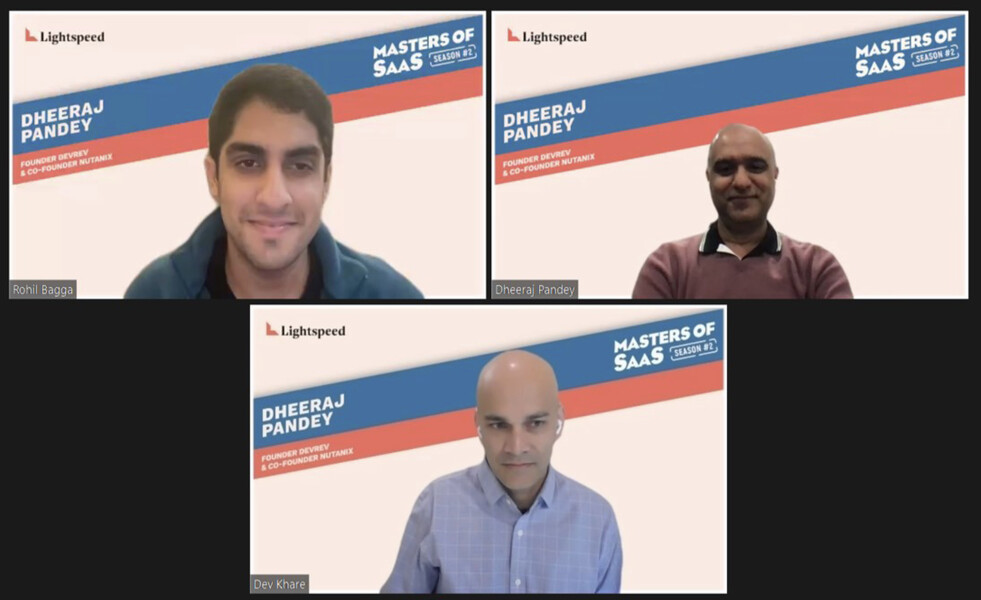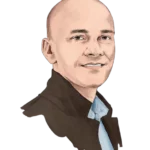
In the second conversation of our Masters of Saas Season 2, we spoke to Dheeraj Pandey, best known as the founder of Nutanix, and DevRev. Nutanix was backed by Lightspeed and went public in 2016.
He also sits on the board of Adobe, is an advisor at the University of Texas, Austin and has co-founded other ventures in the past too. It was great to hear from Dheeraj on how his early experiences shaped his career and entrepreneurial journey. He has been through the worst economic cycles, and come out strong, leaning on the Sanskrit verse “etadapi gamisyati” (This too shall pass).
The conversation was peppered with anecdotes and learnings and how the SaaS journey with DevRev is different from the ones he has embarked on before.
Dheeraj grew up in India in the early 1980s, and made it to one of India’s best engineering colleges, the Indian Institute of Technology, Kanpur. A couple of months into college, he was unhappy with the course he had gotten. So, he quit college and retook the exam. Just for context, the acceptance rate into an IIT is anywhere between 0.5% and 2.5%, whereas at MIT is 7%. And yet, he made it to his chosen course.
“It comes down to this idea of being resolute about things, and the fact that you don’t get perturbed. It is so important for entrepreneurship and starting a company and hiring people,” he says. It makes sense then that his family and friends call him Atal or resolute.
Dheeraj founded Nutanix in 2009, which was the first company to deal in hyperconverged infrastructure. Its technology brings together server, storage and virtualization software in one machine. It went public in 2016, and Dheeraj retired from his first company to begin building DevRev, which focuses on bringing developers closer to customers and revenue.
There was much to learn in this free wheeling conversation with Dheeraj, and his experiences of building two very different types of businesses.
Product building: The MAYA Principle
Dheeraj is known to apply the MAYA (Most Advanced. Yet Acceptable) Test to business building. It is a design principle introduced by Raymond Loewy, who is considered the father of industrial design. A classic example of a product that didn’t pass the MAYA test is Google Glass, not just because it wasn’t socially accepted, but also because it is important to take into account human fatigue with AR/VR gear.
He shared how and why it is important for founders to apply the MAYA Test:
- It is important to take advancement to the enterprise, but founders should also know how to weave through it.
- Resist the temptation to change the customers’ existing systems or uproot their old ways of working.
- Win customer trust, one small step at a time.
- Having a seat at the (customer’s) table will give you the chance to take more of your newer products and offerings to them.
Surviving: Normalise near-death experiences
During this journey, Nutanix also had some near-death experiences, which, according to Dheeraj, should be normalised in a company’s journey.
There was a time in 2014 when VMware, whose virtualisation Nutanix simplifies, refused to work with Nutanix. As a result, Nutanix had to figure out how to build a hypervisor, a software that runs and manages one or more virtual machines. It also had to continue working with its existing customers.
The key to going surviving times are:
- Focus on keeping your customers happy
- Even if you are a small startup, keep your design and processes simple
- While working with incumbents, do your part of the job better than their own products
- Keep going, do not get perturbed. Derive energy from happy customers
Engineering: The power of keeping it simple
Dheeraj believes simplicity trumps everything. When you simplify complex things for your customers, everyone wins. But all simple designs did not begin by being universally acceptable. They took time, perseverance, and the power of the community.
When the first iPhone was launched, it didn’t do well. So Apple opened up everything for the community. The compass, accelerometer, oscilloscope, and let the community drive usage and everything else. It worked, and how.
The Salesforce SaaS success story rests on the company opening up APIs for everyone, and making them remotely accessible, without the need for a Firewall or a VPN. And a whole community of people implemented Salesforce for small and medium businesses in the first decade of operations, unseating Oracle Siebel. Simple design always wins.
A common refrain we hear from engineers at startups is how to keep things simple?
Engineers love to build, they want to add more features, a new capability, or a complementary product. How does one know or learn to keep it simple? According to Dheeraj, through the power of community and crowdsourcing:
- Keeping product analytics and usage data among four or five product managers narrows the scope for innovation
- Provide a wider set of engineers access to product insights
- While building features for a B2B product, resist the temptation to do them all by yourself
- Build platforms that make it easier for a wider community to bring in new features
The SaaS challenge: Building DevRev
The challenges building DevRev, a SaaS firm, with employees scattered across the world (India, Slovenia, US, Argentina), are very different from those Dheeraj navigated at Nutanix.
The first of these is how to manage remote work, and align with the employees’ time zones. Building trust with customers takes time. Product onboarding is a challenge, says Dheeraj, and DevRev is taking a hybrid product led growth (PLG) approach.
Some takeaways on how to approach some of these issues, especially in the early stage:
- Accept that sales and buying are going to be done remotely
- Begin small. Target the SMB segment before going to enterprise. Salesforce grew the same way
- Think of SaaS selling in terms of bite-sized deals. Target $5-20,000 deals
- Find the right balance between hiring mid-market enterprise sales people and keeping product zero touch
- Being frugal with spending your funds. Thinking you have very little creates a constraint that mothers invention.
Moving to the US: What’s the pixie dust?
Founders making the move from India want to find the magic dust that will make the move to the US successful for them. But it is rarely as easy as a little sprinkle of dust.
Dheeraj’s playbook says the first thing is to settle your family in the US. Make them comfortable. Secondly, finding really good talent, especially in sales, is important. Founders have to be great storytellers to be able to attract these high achievers and then make them feel like first among equals. This is the only currency founders have, apart from their customers, in the early years.
Then, there are a few things to look out for:
- Be ready and open to the cultural changes the move brings
- Be prepared to let go of hierarchical structures
- Treat your people well. They need to feel like they are a part of your company, your vision
- Equity, compensation and incentives, all have a role to play
- Be human, especially during down cycles
- Get the best out of your best people
It was a session with very relatable learnings for our founders. We will continue to share insights from this and upcoming sessions, as we go along. Stay tuned to #MastersofSaaS.
Authors



